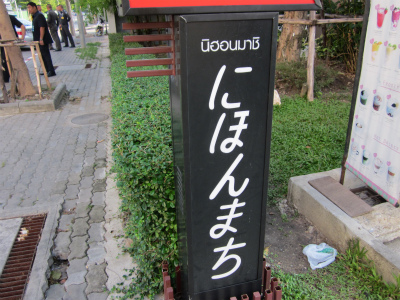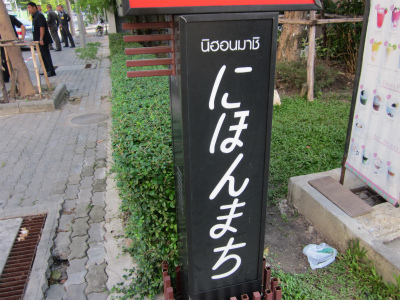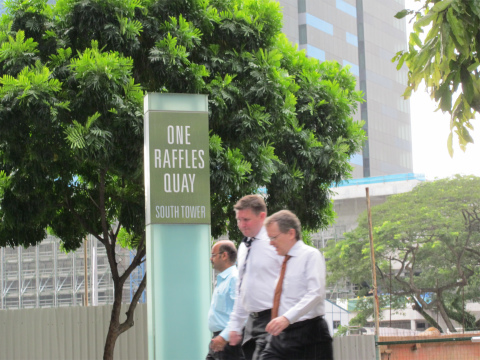東南アジアで思うこと。

今回は、20日のホーチミンでのFC事業セミナーに始まり、バンコク、シンガポールと実に様々な国で、都市で、モールや飲食店舗を見てきた。地元企業の店舗、日本のFCチェーン、日本もどきの店舗。いろいろ。。。
思うのは日本で有名な店舗が海外に出店していても、その味は日本と全く違う店舗もあるということだ。
本来FC、あるいは同じ看板を掲げるのであれば、加盟店のその味や雰囲気、サービスに対して本部は指導する責任をもつ。同じ看板を掲げて営業していく以上それは至極当然のこと。
国内であれ、海外であれそれは同じはず。
その国の国民は、その店舗の味をそのチェーンの味と信じこむ。
美味しくない場合は、このチェーンは「不味い」と刷り込まれる。
そしてそれはこの先何年にもわたって消えることはない。
本部にしてみれば、その国で競争に敗れたのとおなじ。。。
その先、何十年もとり返しがつかない。
創業時、その創業者はブランドを自分の子どものように可愛がる。
子どもが3人になった(3店舗)10人になった(10店舗)と喜び、その成長を楽しみに、時には厳しくしかりつけ成長を促す。
いつの頃からか、その成長に関心がなくなりチェーンは衰退していく。
親の関心がなくなった子供は非行に走り、やりたい放題、勝手なことをする。
味もメニューも勝手に変わり、本質の基軸をぶれさせてなに屋さんかわからなくなる。
よくある衰退のパターン。
国内ならまだしも、海外で子供に非行に走られると手におえない。
適宜見えないし、指導の方法がないからだ。
特に海外に出た子供には、周りから「この国ではこれではだめですよ。」「この国の人たちは、こういう味、こういうメニューが好きなんです。」と悪魔の囁き攻撃をかける。里親はたまったもんじゃない。「そういうもんかなー」と考え始め基軸をぶれさせてしまう。
どこの国に行ってもぶれさせてはいけない基軸がある。本質というものだ。
あまりにも違う日本の有名店の料理をこちらで食べてつくづくそう思った。
同じ看板が泣いている。この国でこのブランドのレピュテーションはもう補えない。。。
こういう話をすると、日本の料理を海外でアレンジして成功した事例もあるではないかと言われる。例えば熊本の味千ラーメン。中国では日本風料理店、居酒屋のような業態になっている。
私がデシー(中国の味千の女性創業者)に2回ほど会って感じたのは、まったくなんでも好き勝手やってるのではないということだ。
私からするとデシーも本質は決してぶれてはいない。と感じている。
深く知らない人たちは、「自国にカスタマイズした成功事例」、「国にあわせて業態を変えていかないといけない」という。。。ちがうんだけど。。。
なにはともあれ、守り続けないといけない部分、事業や業態の基軸をぶれさせて展開してもその先に成功はないということだ。
アジアでは今ままで、本格的な日本の飲食チェーンが進出していなかった。
現地企業が名目だけ、和風・・・・で十分に商売ができた。
これからは違う。今回の震災は本当の日本の味を知ってもらうよい機会だと思っている。
逆風に帆を上げて!
アジアの人たちも日本に行く機会が増え、本来の味を知り始めている。
今まで自分たちが食べていた和風パスタ、ラーメン、寿司、なんか違うと感じ始めている。
大きなチャンスがここにある。本物を知っている日本人だけができること。
ほらね。そこにありますよ。
アセンティアホールディングス
土屋
English ↓
What I think in Southeast Asia!
This time, starting with the franchise business seminar in Ho Chi Minh City on the 20th, we have seen malls and restaurant stores in Bangkok, Singapore, and so many other countries and cities. I have seen stores owned by local companies, Japanese franchise chains, and stores that look like they are made in Japan. I have seen many different types of stores.
I think that even though some famous Japanese restaurants have opened overseas, their tastes are completely different from those of their Japanese counterparts.
If they are franchisees, or if they carry the same sign, the head office has the responsibility to provide guidance to the franchisees regarding the taste, atmosphere, and service. This is quite natural as long as they are operating under the same sign.
It should be the same whether the restaurant is in Japan or overseas.
The people of the country believe that the taste of the restaurant is the taste of the chain.
If it is not good, the chain is imprinted as "tasteless.
And that will not disappear for years to come.
For the headquarters, it is the same as losing the competition in the country.
It will be irreversible for decades to come.
At the time of establishment, the founder loves the brand as if it were his own child.
He would look forward to the growth of his three children (three stores) or ten children (ten stores), and at times he would harshly discipline them to encourage their growth.
At some point, they lose interest in their growth and the chain declines.
The children, who have lost the interest of their parents, become delinquent and do whatever they want, as they please.
Tastes and menus change on their own, and the essential axis of the restaurant becomes blurred, and it becomes hard to tell what the restaurant is about.
This is a common pattern of decline.
If it is in Japan, it is not so bad, but if it is overseas and the children misbehave, it is out of control.
This is because they cannot see what is appropriate and there is no way to guide them.
Especially for children who have gone abroad, people around them say to them, "You can't do this in this country. People in this country like this kind of taste and this kind of menu. The foster parents are not happy. The foster parents were not happy. They start thinking, "That's the way it is.
No matter where you go, there is a fundamental principle that must not be allowed to waver. It is the essence.
I felt this way when I ate dishes from famous Japanese restaurants here, which are so different from each other.
The same signboard is crying out. The reputation of this brand in this country can no longer be compensated for.
When I talk about this, I am often told that there are examples of Japanese cuisine that have been successfully adapted for overseas consumption. For example, Kumamoto's Ajisen Ramen. In China, it has become a Japanese-style restaurant, similar to an izakaya (Japanese style pub).
What I felt when I met Dessie (the female founder of Ajisen in China) twice is that she is not doing whatever she wants at all.
From my point of view, Dessy is not out of touch with the essence of the business. I feel that.
People who don't know much about it say that it is a success story customized for their country, or that they have to change their business model to suit their country. I don't agree with them.
At any rate, there is no success in the future if the core of the business and business model that must be protected and developed remains unchanged.
In Asia, there have been no full-fledged Japanese restaurant chains.
Local companies were able to do business only in name and in Japanese style ・・・・.
From now on, it will be different. I believe that this earthquake is a good opportunity to let people know the real taste of Japan.
Sailing into the headwind!
More and more Asian people are visiting Japan, and they are beginning to know the true taste of Japan.
They are beginning to feel that the Japanese pasta, ramen, and sushi they used to eat are different from what they are used to.
There is a great opportunity here. Only Japanese people who know the real thing can do it.
You see? It's right there.
Assentia Holdings Inc
Akira


